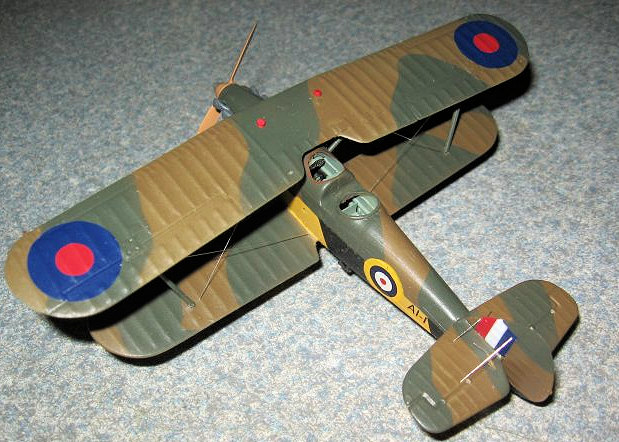
Recycled 1/72 Airfix Hawker Harts and Demons
by Brian Baker

| BACKGROUND |
I like to refurbish old models. This involves taking old, scrapped models built years ago, and breaking them apart and soaking them in automotive brake fluid to remove the paint, decals, and old glue. Once the models are processed, they are ready to be rebuilt and restored to life.
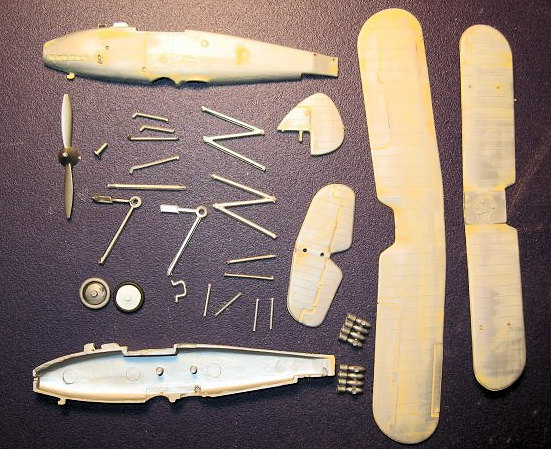 Why, you might ask, would any rational person do
this when you can just build a model straight from the box? The answer is that
we are all insane to a certain degree, some more than others, and I couldn’t see
just wasting some of those old models—they deserve a second chance. So several
months ago, I went into my old model scrap box and picked out a number of old
Airfix Hawker Hart and Demon models that I would rebuild, just to see if it
could be done. The answer was that it can, but it is a lot of work.
Why, you might ask, would any rational person do
this when you can just build a model straight from the box? The answer is that
we are all insane to a certain degree, some more than others, and I couldn’t see
just wasting some of those old models—they deserve a second chance. So several
months ago, I went into my old model scrap box and picked out a number of old
Airfix Hawker Hart and Demon models that I would rebuild, just to see if it
could be done. The answer was that it can, but it is a lot of work.
I should mention at this point that the Airfix kit was not the first 1/72 issue of the Hart series. Before the war, the old Frog Penguin series included a model of the Hawker Hind Trainer, which had two pilot-type cockpits. It is very similar to the Airfix Hart kit in most repects. Some of these have been reissued, and I have one of these. For its day, it was a masterpiece.
There is a lot of material available on the Hawker series of bombers, fighters, and army-cooperation types. Probably the best source of information is the Mushroom edition of “The Hawker Hart Family” by Alex Crawford. This book has photos, 1/72 scale drawings, color profiles, and detail photos of restored examples displayed throughout the world. The old Profile Publications on the Hart and Audax are also useful. You will need three views and detail photos to do anything serious with these old kits.
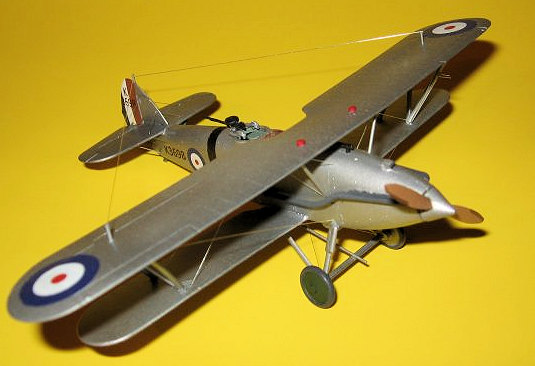 The Hart series was built in numerous variations,
differing primarily in cockpit configuration, armament, and powerplant. When the
original Hart outran the RAF’s current fighters, a fighter version, the Demon,
quickly appeared. This was followed by the Audax, an army cooperation type, and
other variants were eventually developed for the RAF, Royal Navy, and foreign
air forces. These include the Osprey for the Navy, and the Audax, Hardy, Hind,
Hector, and Hartbeeste for the RAF. Foreign users included Afghanistan, Belgium,
Egypt, Erie, Estonia, Iraq, Latvia, Persia, Portugal, Spain, Sweden,
Switzerland, and Yugoslavia. Swedish Harts were used in Finland by volunteer
units against the Soviets during the Winter War, and some Latvian, Estonian, and
Persian Harts were captured and flown by the Russians. There were numerous
powerplants involved also, both liquid cooled in-line engines and air cooled
radials. With this great variety, it is possible to build twenty or thirty
models of the series without duplication.
The Hart series was built in numerous variations,
differing primarily in cockpit configuration, armament, and powerplant. When the
original Hart outran the RAF’s current fighters, a fighter version, the Demon,
quickly appeared. This was followed by the Audax, an army cooperation type, and
other variants were eventually developed for the RAF, Royal Navy, and foreign
air forces. These include the Osprey for the Navy, and the Audax, Hardy, Hind,
Hector, and Hartbeeste for the RAF. Foreign users included Afghanistan, Belgium,
Egypt, Erie, Estonia, Iraq, Latvia, Persia, Portugal, Spain, Sweden,
Switzerland, and Yugoslavia. Swedish Harts were used in Finland by volunteer
units against the Soviets during the Winter War, and some Latvian, Estonian, and
Persian Harts were captured and flown by the Russians. There were numerous
powerplants involved also, both liquid cooled in-line engines and air cooled
radials. With this great variety, it is possible to build twenty or thirty
models of the series without duplication.
| THE KITS |
Many years ago, I believe in the fifties, Airfix
produced a series of 1/72 scale models of British aircraft, of such airplanes as
the Gladiator, Spitfire, Hurricane, Lysander, and many others. One issue that
was probably one of the better ones was the Hawker Hart bomber. In those days,
there was no cockpit detail,
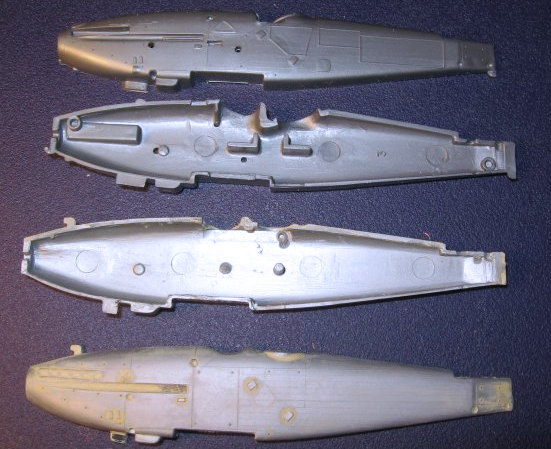 and other features were sometimes crudely done, but
the Hart had fairly nice detail, especially on the fuselage exterior. The one
feature of the kit that makes it valuable is the exterior cockpit detail, with
the pilot’s and gunner’s positions in the form use by the Hart. Many years
later, probably in the early seventies by my failing memory, Airfix reworked the
molds to produce a pretty competent kit of the Hawker Demon, the fighter
variant. Not only did they modify the fuselage and rear gunner’s position, but
they also reworked the wings and tailplane, adding rib detail and some of the
protrusions common to biplanes of that era. They also provided a new
gun-mounting ring, and the Lewis gun was a little better. The Hart kit had flush
exhausts common to that series, while the Demon kit has the long stacks typical to the Demon. However, no more Harts kits
were produced, making this a collectors’ item. Burns’ 2003 “Plastic Aircraft
Kits of the Twentieth Century” lists the Hart at $15-20, and the price has
probably gone up since then. So if you have any, hang on to them. There are some
kits of the types currently available, including A-Model’s Hector and Osprey,
but even though they have much more detail, I’m not convinced that they are
really that much better than the old Airfix kits. Now maybe the new Airfix
management might see fit to reissue the kit to modern standards, like they did
with some of their current reissues. That would be something to look forward to.
and other features were sometimes crudely done, but
the Hart had fairly nice detail, especially on the fuselage exterior. The one
feature of the kit that makes it valuable is the exterior cockpit detail, with
the pilot’s and gunner’s positions in the form use by the Hart. Many years
later, probably in the early seventies by my failing memory, Airfix reworked the
molds to produce a pretty competent kit of the Hawker Demon, the fighter
variant. Not only did they modify the fuselage and rear gunner’s position, but
they also reworked the wings and tailplane, adding rib detail and some of the
protrusions common to biplanes of that era. They also provided a new
gun-mounting ring, and the Lewis gun was a little better. The Hart kit had flush
exhausts common to that series, while the Demon kit has the long stacks typical to the Demon. However, no more Harts kits
were produced, making this a collectors’ item. Burns’ 2003 “Plastic Aircraft
Kits of the Twentieth Century” lists the Hart at $15-20, and the price has
probably gone up since then. So if you have any, hang on to them. There are some
kits of the types currently available, including A-Model’s Hector and Osprey,
but even though they have much more detail, I’m not convinced that they are
really that much better than the old Airfix kits. Now maybe the new Airfix
management might see fit to reissue the kit to modern standards, like they did
with some of their current reissues. That would be something to look forward to.
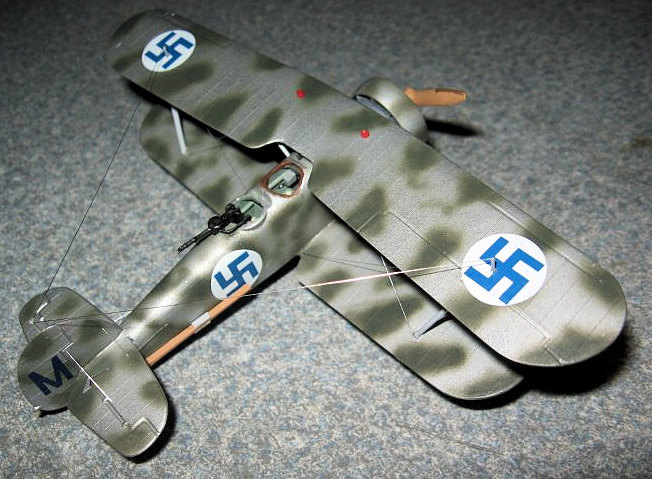 I had approximately five or six scrapped Harts and
Demons to start with, plus an additional seven unbuilt kits. I had already built
five kits a few years back, so I decided to do two Harts and two Demons. One of
the scrapped kits was the Swedish version with the Bristol Mercury engine, which
was taken from a Frog Westland Wallace kit, another very nice old kit that can
be built with a variety of engines. I began by disassembling the models, soaking
them in brake fluid to remove the paint and glue, cleaning up the parts, and
rebuilding them. For details, see my previous article on recycling old kits.
With all of the models, I built up interiors based on photos from the Crawford
book. Since I was doing four models at once, this was done on almost a mass
production basis, although the interiors of the Hart and Demon kits were
slightly different. They all required removal of the interior pegs and “seats”
so that sidewall detail could be constructed. I scratchbuilt the seats and
instrument panels, and fabricated control sticks with those little rings on top
so peculiar to British aircraft of that day. I found some small metal rings in a
craft store that worked out perfectly.
I had approximately five or six scrapped Harts and
Demons to start with, plus an additional seven unbuilt kits. I had already built
five kits a few years back, so I decided to do two Harts and two Demons. One of
the scrapped kits was the Swedish version with the Bristol Mercury engine, which
was taken from a Frog Westland Wallace kit, another very nice old kit that can
be built with a variety of engines. I began by disassembling the models, soaking
them in brake fluid to remove the paint and glue, cleaning up the parts, and
rebuilding them. For details, see my previous article on recycling old kits.
With all of the models, I built up interiors based on photos from the Crawford
book. Since I was doing four models at once, this was done on almost a mass
production basis, although the interiors of the Hart and Demon kits were
slightly different. They all required removal of the interior pegs and “seats”
so that sidewall detail could be constructed. I scratchbuilt the seats and
instrument panels, and fabricated control sticks with those little rings on top
so peculiar to British aircraft of that day. I found some small metal rings in a
craft store that worked out perfectly.
In the past, when I built a Hart, I replaced the wings from those from a Demon because of the better detail, but after looking at the wings from both kits, I concluded that the Hart’s wings and tailplane were probably a little underdetailed, while the Demon units were overdone. This makes both units acceptable, so the models are pretty much stock. They are interchangeable, however, and Demon parts can be used on the Hart, and vice versa.
| CONSTRUCTION |
 I did all four models at the same time, and each
stage was done on all four models. Once the cockpits were detailed, the fuselage
halves were joined and the seams filled in. The lower wings were attached to the
fuselage, along with the tailplanes, and at that stage, after suitable
preparation, I painted the airframes. Once the kits were painted, I assembled
the upper wings and landing gear. I usually do biplane wings by attaching the
outboard “N” struts first before installing the upper wings. Then, I measure the
inboard cabane struts and glue them in place.
I did all four models at the same time, and each
stage was done on all four models. Once the cockpits were detailed, the fuselage
halves were joined and the seams filled in. The lower wings were attached to the
fuselage, along with the tailplanes, and at that stage, after suitable
preparation, I painted the airframes. Once the kits were painted, I assembled
the upper wings and landing gear. I usually do biplane wings by attaching the
outboard “N” struts first before installing the upper wings. Then, I measure the
inboard cabane struts and glue them in place.
Once the main assembly was done, I applied the decals and markings. Decals from the spares box were used for most markings, but I did my RAF, RAAF, and RNZAF serials on the computer. Once the decals were in place, I did the final detailing, such as control horns, steps, and other specifics. I used my technique of unstranded electronic wire for rigging and control cables, installing the wires in order so that the next ones could be attached without fishing them through and behind the wires already installed. Last, the radio antenna wires were put in place, and the models were then finished.
| CONCLUSIONS |
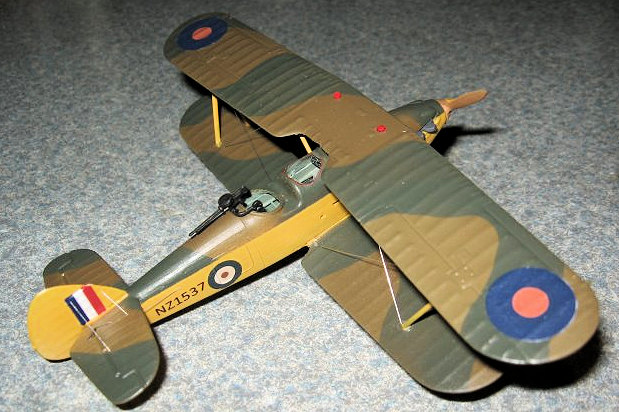 If you’ve never tried an Airfix Hart or Demon, I’d
certainly suggest that you try one. They are very basic kits, but with a little
time and effort, a first class model can be built. And besides, every 1/72 scale
model collection should had at least one of these beautiful little biplanes in
place. And the Demons are so readily available. Maybe they will reissue or
retool the kit. Are you listening, Airfix?
If you’ve never tried an Airfix Hart or Demon, I’d
certainly suggest that you try one. They are very basic kits, but with a little
time and effort, a first class model can be built. And besides, every 1/72 scale
model collection should had at least one of these beautiful little biplanes in
place. And the Demons are so readily available. Maybe they will reissue or
retool the kit. Are you listening, Airfix?
July 2016
Copyright ModelingMadness.com
If you would like your product reviewed fairly and fairly quickly, please contact the editor or see other details in the Note to Contributors.